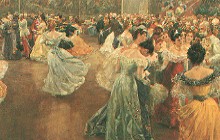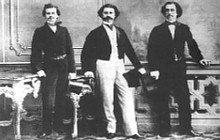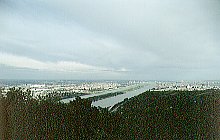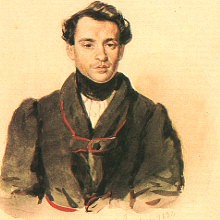| [naar
inhoudsoverzicht Strauss-dynastie]
[naar
literatuurlijst]
inhoud:
|
THE KINGS OF WALT
The Kings of waltz
| Today the composer Johann Strauss Son is primarily associated with
the notion "Viennese waltz". Johann Strauss Father is considered at best
as the "trailblazer" of his famous son, but he as well as Joseph Lanner
are in his shadow without good reason, for they both contributed decisively
towards the development of the dance music in the first half of the 19th
century: |

The "Hofball" (Aquarell, 1900) |
They perfected artistically this genre and gave to it individual characteristics
by independent and unmistakable dance forms.
The emancipated Viennese bourgeoisie of the 19th century endeavored
to adapt the formalities of the imperial court for its situation. Balls
were no longer the privilege of the nobility: In dance halls, pubs and
public gardens large dances were performed which gave also the lower classes
the opportunity of amusement. At carnival time, any larger tavern organized
at least one ball and the crush was so great that more and more new establishments
with large dancing rooms were built.
Dances had to be registered officially (they were prohibited in principle
on Sundays and holidays). Such festivities yielded considerable tax returns
to the state and also the music publishers, which offered the dance music
in innumerable arrangements, profited from them. The public longed always
for new compositions. The pieces were just played throughout one season.
Most of the freelance composers seized their opportunity to make some money
on the side with dance music, even Ludwig van Beethoven and Franz Schubert
did not refuse to compose for this genre.
The bourgeois Vienna danced most of all the traditional folk dances
ländler, waltz, polka, gallopade. In the houses of the nobility the
Baroque court dances were kept up for some time, but minuet, gavotte or
saraband were soon supplanted by the waltz.
In the 18th century the folk dances were not yet clearly differentiated
from one another. Joseph Lanner and Johann Strauß Father
gave to the genres waltz and ländler, march and gallopade an own musical
character and a more or less homogeneous form with introduction, a sequence
of five or six dances and finale. The individual parts are often linked
to each other by motive and thematic relation. The Strauss sons, Johann,
Josef and Eduard, referred to this form pattern and developed it further.
Johann gave different extensions to the individual parts and putted them
in thematic relation to one another. Josef composed even symphonic concert
waltzes, atmospheric descriptions which had often nothing in common with
cheerful dances and leaned on Liszt and Wagner in form and content. Eduard
was the least gifted of the brothers for composition, but he was an excellent
conductor. He cultivated the music of Lanner, his brothers and his father
till after the turn of the century.
The Strauss sons, Johann, Josef and Eduard, referred to this form pattern
and developed it further. Johann gave different extensions to the individual
parts and putted them in thematic relation to one another. Josef composed
even symphonic concert waltzes, atmospheric descriptions which had often
nothing in common with cheerful dances and leaned on Liszt and Wagner in
form and content. Eduard was the least gifted of the brothers for composition,
but he was an excellent conductor. He cultivated the music of Lanner, his
brothers and his father till after the turn of the century.
 The
Strauß-Dynasty The
Strauß-Dynasty
On July 11th 1825, Johann Strauss married Maria Anna Streim (1801-1870).
| Her father, Josef Streim, was the owner of the beer tavern "Zum
goldenen Brunnen" (today Wien 9., Thurygasse 3). The young couple
lived first in St. Ulrich No. 76 (Wien 7., Lerchenfelder Straße 15),
here Johann Strauss junior was born. A year later, they moved to Mariahilf
No. 865 "beim Kreuz und beim Ritter" (Wien 6., Mariahilfer Straße
65 / Nelkengasse 8), where Josef Strauss was born. |

Vienna 7th district,
Lerchenfelderstr.15 |
In 1828/29, the family settled in the Leopoldstadt. Within four years,
the Strauss family moved two times: In February 1830, they had to leave
the house "Zum weißen Wolfen" in the Donaustraße as
a result of an inundation and moved in the house "Zum Einhorn" (Wien
2., Karmelitergasse 7). From 1832/33 on, they lived in the house "Zum
goldenen Hirschen", also called "Hirschenhaus" (Wien 2.,
Taborstraße 17), where nearly the whole first floor (13 rooms
and 3 kitchens) was at their disposal. Here, the children Ferdinand (1834)
and Eduard (1835) were born.
From 1828 till 1834, Johann Strauss spent the summer months in the house
of the parents-in-law in Salmannsdorf (Wien 19., Dreimarksteingasse
13).
Johann Strauss and his wife had six children: Johann (1825-1899), Josef
(1827-1870), Anna (1829-1903), Therese (1831-1915), Ferdinand (1834) and
Eduard (1835-1916).

The three sons: Eduard, Johann, Josef |
Although the father neglected more and more his children and finally
parted from the family, he took the decision on the scholastic education
of the three sons. Father and mother agreed that they would not enter the
career of professional musicians despite their outstanding talent, but
practice music only in the family circle. |
From 1837 till 1841, Johann and Josef went to the reputed Schottengymnasium.
Then, they were supposed to attend an university. The Moravian teacher
and organist Wenzel Plachy gave them piano lessons. Unknown to his fateher,
Johann took also violin lessons, which he financed himself by piano lessons.
In 1841/42, both brothers began their vocational training at the commercial
department of the k.k. Polytechnisches Institut (Imperial and Royal
polytechnic institute today Technische Universität, Wien 4., Karlsplatz
13).
| By and by, Johann Strauss became estranged from his family. He met
the milliner Emelie Trampusch (1814-1857) and led with her a double life.
They had seven children. After the definitive rupture with his wife Anna,
Johann Strauss left the Hirschenhaus in 1843 and moved with his
second family into the house Leopoldstadt No. 245 (Wien 2., Lilienbrunngasse
18). Anna Strauss fought three years for the divorce, which was granted
in January 1846. |
 |
In 1848, Johann Strauss moved with the Trampusch family to the Innere
Stadt No. 817/829 (Wien 1., Kupfgasse 11). He died of scarlet fever
there on September 25th 1849. As Joseph Lanner, he was interred at the
old
Döblinger cemetery. Today, his tomb is at the Zentralfriedhof
(Ehrengräber-Gruppe 32 A, No. 15).
Joseph Lanner (1801-1843)
src="
The Strauß-Lanner-monument
in the Vienna-Stadtpark
As early as 1830, the Viennese public, fond of dancing, was split in
two factions: The "Straussians" enjoyed the pointed rhythmic of the waltzes
by Strauss, the "Lannerians" were enthusiastic about the ingenuity of their
favorite. During his lifetime, Joseph Lanner was at least as famous as
his fellow combatant and rival Johann Strauss, but his fame waned soon
because of his early death, the coming in of the operetta and the growing
popularity of Johann Strauss Son.
Today, his extensive works are known just in fragments. 209 compositions
were published: waltzes, polkas, quadrilles, ländlers (Styrians),
marches, gallopades and potpourris. Numerous works were preserved as autographs,
in addition to dances also arrangements of operatic arias and overtures
as well as a string quartet. His compositions bear sometimes romantic imaginative
titles, sometimes titles aimed at concrete events and occasions emphasizing
the topicality of his works. This topicality, often provoked by innkeepers
or publishers, also contributed to label Lanner as fashionable composer
fated to be replaced by other fashionable complaints.
Origin
Joseph Lanner was born on April 11th 1801 in Vienna, St. Ulrich No. 10,
today Wien 7., Mechitaristengasse 5 as son of a glover journeyman
and baptized at the church of St. Ulrich. His father set up later
his own shop and Joseph Lanner probably learned the craft of his father.
Though nothing is handed down about his scholastic and musical education
- his perfect violin play and the quality of his compositions speak for
well-founded studies of music, which are nevertheless not confirmed by
any sources.
Even about the beginnings of his musical career we do not know more
than that he is supposed to have played after 1820 in pubs in the environs
of Vienna and in urban inner courts with two violinists and the
violist Johann Strauss.
Johann Strauss Father (1804-1849)

Johann Strauss Father
Origin
Johann Strauss' father was Franz Borgias Strauss (1764-1816). He lived
in the Leopoldstadt, Vienna's today's second municipal district. In 1797,
he married Barbara Dollmann (1770-1811). Four of six children of the couple
died already in the first year of their life. Franz Borgias was first waiter
in different beer taverns. In 1803, he purchased the local "Zum heiligen
Florian" in the Leopoldstadt No. 53 (today Wien 2., Floßgasse
7) and took the civil oath. From 1808 on, he is supported by documentary
evidence as innkeeper at Leopoldstadt No. 432 (Wien 2., Weintraubengasse
1). Widower in 1811, he remarried in the same year. At this time, he
was probably already heavily indebted. In 1816, he met his death in the
Danube under uncleared circumstances.
Johann Strauss became acquainted with the contemporary light music as
a little child at the tavern of his father, when he listened, sitting under
a table, to the musicians. After the death of his father, he became an
apprentice with a bookbinder and passed his final examination in 1822.
The facts about his musical education are lacking, but we know that he
opted deliberately for the career as musician.
|





